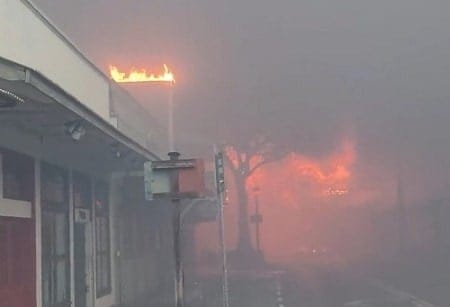At yesterday’s press conference in Maui, a New York Times reporter asked Maui’s fire chief, Bradford Ventura, and Maui Emergency Management Agency Administrator, Herman Andaya to comment on why sirens were not sounding and no prior warnings were being given to residents and visitors in Lahaina.
When the reporter also asked why Maui’s fire chief or his top emergency management official was not in Maui well knowing a hurricane may be causing unexpected problems, the States PR representative told all attending journalists to be more sensitive with her questions, since people in Maui are going through a lot.
US Senator Mazy Hirono said at an earlier press conference in Honolulu: We need all hands onboard.
Today, Hawaii-based Civil Beat Media alleged in an article published today that the warning has been sounded for years.
Bradford Ventura, Chief of the Maui Fire Department, said in that press briefing that the fire reached Lahaina so quickly that residents of the first neighborhood it hit “were basically self-evacuating with fairly little notice.”
Most of the electricity on the island is still circulated above ground. Therefore, it’s not clear whether Hawaiian Electric Co., which includes Maui Electric Co., had protocols in place to shut down power beforehand when a red flag warning for high winds was issued. Such a red flag warning was active for Maui at the time of the disaster. In other states, such policies are in place to shut down the electricity beforehand.
According to Bissen, 29 power poles had fallen across roads in the area, stifling access to the fire zone. It appears that when electricity poles were thrown on the ground due to the storm, sparks flew and quickly spread the fire.
It also appears that, based on agencies not coordinating in Maui, evacuation orders were not given to the population and visitors.
The person responsible for having given such an evacuation order did not attend the press conference. Herman Andaya is head of the Emergency Management Agency in Maui. He was at the operation center for the press conference.
The official version of the situation about visitors was, that visitors staying at the hotels north of the historic town, of Kaanapali, were asked to shelter in place. This was done in order to help emergency vehicles get into Lahaina.
Lt. Gov. Sylvia Luke said, “We never anticipated in this state that a hurricane which did not make an impact on our islands would cause this type of wildfire: wildfires that wiped out communities, wildfires that wiped out businesses, wildfires that destroyed homes.”
Antiplanner agency Thoreau Institute said in an email:
The Maui fires can be accurately blamed on Hawaii’s land-use law. Native Hawaiian vegetation is normally damp enough that it is fire-resistant.
But much of the native vegetation was removed to make room for pineapple and sugar cane plantations. The plantations were also normally pretty fire-resistant, but the state land-use law drove up the price of housing by so much that farmers couldn’t afford to hire workers because workers couldn’t afford housing on farmworker pay. As a result, Hawaiian agricultural productivity declined by 80 percent.
As farms were abandoned, they were replaced by invasive grasses. Unlike the native and farm vegetation, the grasses were highly susceptible to fire. High winds made those fires impossible to suppress.
So, by making housing expensive, the state land-use law that was passed to protect Hawaiian agriculture in fact destroyed it and set the state up for the fires that are destroying Maui’s tourist industry.
KHON TV reported:
Hawaii emergency management records show no indication that warning sirens sounded before people ran for their lives from wildfires on Maui that killed at least 67 people and wiped out a historic town. Instead, officials sent alerts to mobile phones, televisions, and radio stations, but widespread power and cellular outages may have limited their reach. Hawaii boasts what the state describes as the largest integrated outdoor all-hazard public safety warning system in the world, with about 400 sirens positioned across the island.
67 people are confirmed dead, and 1000+ are missing as of August 11.
What should a tourist or resident of Hawaii do when receiving this emergency reverse 911 warning?
There are minutes to act- there is no time to waste.
The short answer is. Tourists should stay in your hotel and close the windows. Escape into solid brick buildings. Residents seal their windows and doors. Have enough water, food and don’t forget your medication. Have a battery-operated radio and your mobile phone charged. This is the advice officials want the public to know.
In Lahaina, people had seconds and many jumped into the ocean for safety.























